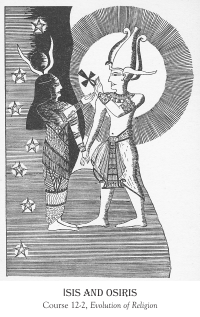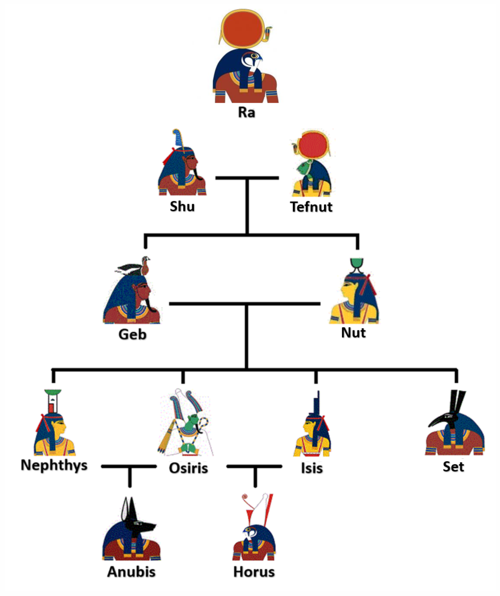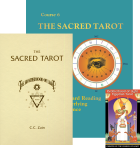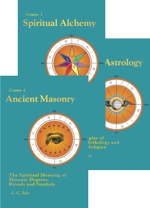|
|
Spiritual Meditations and Exercises Brotherhood of Light Lessons: Course Books on Astrology, Alchemy and Tarot Member Forum - Connecting with Members of Our Community
For Email Marketing you can trust
|
First Published in The Church of Light Quarterly, Summer Edition 2023, Vol 98, No. 3 
The Egyptian Roots of the Brotherood of Light SeriesPart 1 - An Overview of the Heliopolitan Ennead and BOL TheologyJ. A. Miller PhD, Hermetician, Order of the Sphinx“According to our traditions, in the year 2440 BC a group separated from the Theocracy of Egypt, and throughout all subsequent times, as a secret order, the name of which translated into English means, The Brotherhood of Light, has been perpetuated.” The above quote is taken from the “Declaration of Principles of The Brotherhood of Light,” which was written by Elbert Benjamine and published in May of 1915 [1]. From it, we learn that The Brotherhood of Light (BOL) originated in Egypt at the end of the Old Kingdom, comprised adepts who were previously a part of the Egyptian Theocracy, and has been perpetuated as a secret order throughout all subsequent times [2]. How do we know that the BOL originated at the end of the Old Kingdom? The Old Kingdom is commonly considered to be that time period of over 500 years that included the 3rd through the 6th Dynasties [3]. In his book, Astrological Lore of All Ages, Benjamine gives a fuller account of the origins of the BOL and describes it as occurring after the 12-year reign of Queen Nitokris [4]. According to modern scholarship, she is considered to perhaps have been the last pharaoh of the 6th Dynasty [5]. At the time of Benjamine‘s writing, the Old Kingdom was considered to have ended in 2440 BC. However, modern scholarship has revised that date to 2181 BC [6]. Understanding this modern revision in dating, Benjamine‘s writing unequivocally places the origin of the BOL at the end of the Old Kingdom. Interestingly, we also learn that prior to their separation from the Theocracy, the group of adepts who would form the BOL, was clearly part of the Theocracy of the Old Kingdom. The term “theocracy” refers to the priestly class and theological center (i.e., “religious authority”) that had a dominant influence over the rulers and people of Egypt at the time. In the Old Kingdom, the dominant theological center and cult was Heliopolis [7] and its nine principle gods called “the Heliopolitan Ennead.” How do we know this? Among other lines of evidence, we can easily see that many of the sons and grandsons of the Pharoah Khufu, who was responsible for the building of the Great Pyramid, all had “Ra” in their names: Djedef-ra, Khaf-ra, and Menkau-ra. Djedefra was also the first pharaoh to use “Son of Ra” as a royal title [8]. It is also during the Fifth Dynasty of the Old Kingdom that we see the first appearance of sun temples dedicated to Ra [9]. Given that these BOL adepts, prior to their separation from the Theocracy, were part of the ruling priestly class, they were likely involved in influencing the formation of the theology of Heliopolis. Thus, we can reasonably surmise that the basic BOL doctrines may be encoded in the theological stories and symbols of the principle gods of Heliopolis. Indeed, Elbert Benjamine has already essentially indicated as much when, in the Egyptian Initiation Chapter of Course 2, Astrological Signatures, he tells us that Osiris, one of the principle Heliopolitan gods, represents the separation and reunion of the Twin Souls — a main BOL doctrine. In ‘decoding' this one theological symbol, he has given us a “key” that allows us to ‘decode' the other theological symbols of the Heliopolitan Ennead to reveal other central BOL doctrines. In this first article of an intended series, the goal is to provide the reader with a brief introduction to the principle gods of the Heliopolitan Ennead and to make the initial connection between these theological symbols and the key doctrines of The Brotherhood of Light. Future installments will examine each of these key teachings and their associated Heliopolitan theological icons individually. At the conclusion of this series, it is hoped that the reader will realize that The Brotherhood of Light key doctrines have a natural, clear, and significant association with the theological icons of Heliopolis — an association which is too great to be accounted for by mere coincidence. It is in the light of such a realization that the truth regarding the origin and Egyptian roots of The Brotherhood of Light, as given by Elbert Benjamine, becomes evident. The Heliopolitan ‘Ennead’During the Old Kingdom, the center for the Cult of Ra was the city known in Greek as “Heliopolis” (meaning “City of the Sun”) or in Egyptian as “Iunu” (which literally means “The Pillars”). In the Old Testament, it is known as the city called “On.” What little remains of it is located in a district of modern Cairo. In the Old Kingdom, it was a major religious center in lower Egypt (the Delta Region) and served as the capital of the 13th Nome - one of the 42 districts or provinces which comprised ancient Egypt [7]. The main theological focus of Heliopolis was the promotion of the principle gods of the Cult of Ra, known as the “Heliopolitan Ennead.” Although the Greek term “Ennead” literally means, “the Nine,” this group of principle gods forming the Cult of Ra included several others. So, our consideration here will include the 9 principle ‘gods’ of Heliopolis plus three other important associated deities — all of which comprise the “family” of Ra (see Figure 1 below). 
Arising from the “Waters of Primordial Chaos,” sometimes referred to as a god called “the Nun” (not depicted in Fig. 1) was the self-created sun god, Atum-Ra. Atum-Ra is then said to have given rise to a twin pair of gods by “sneezing out” his son, Shu, the god of the air, and “spitting out” his daughter “Tefnut”, the goddess of moisture” [10]. Shu and Tefnut then gave birth to Nut, the goddess of the Sky and Geb, the god of the Earth. Nut and Geb then gave birth to four children: Nephthys, Set, Isis, and Osiris. Nephthys and Osiris had a son, the god Anubis. Isis and Osiris also had a son, the god Horus. These gods comprise the Heliopolitan “Ennead,” and by considering their attributes and stories, we will, in future installments of this series, examine how they encode the main Brotherhood of Light theological doctrines. The Main Brotherhood of Light Theological DoctrinesThe BOL doctrines we will consider are those concerning the following: (1) the Triune Supreme Deity and Law of Polarity, (2) the 4 Realms and 6 Dimensions, (3) the Cycle of Necessity, (4) the Twin Souls — Separation & Reunion, (5) the Evolution of Consciousness from Chemical to Simple, (6) the Evolution of Consciousness from Rational to Divine, and (7) the Process of Spiritual Alchemy. These are some, not all, of the key doctrines of the Hermetic Tradition of The Brotherhood of Light. It‘s important to note that the “Hermetic Tradition” of The Brotherhood of Light, does not originate with the body of written works such as the Corpus Hermeticum and Ascleapius, dated to the first few centuries C.E., which are associated with figure of Hermes Trismegistus according to modern academia [11]. Instead, for The Brotherhood of Light, the term “Hermetic” refers to “Thoth” the Egyptian equivalent and predecessor of the Greek god “Hermes” [12]. Thoth is an ancient Egyptian god that is referenced in the Pyramid Texts of the 5th Dynasty of Old Kingdom, Egypt. These texts are the oldest written religious literature in the world [13]. Thus, our usage of the term “Hermetic Tradition,” indicates that the BOL doctrines, like Thoth, also extend back to Old Kingdom, Egypt, as does the BOL itself [14]. In future articles, the correspondence between the Heliopolitan gods and the key Brotherhood of Light doctrines indicated will be decoded and articulated. In this first introductory article, a “Theological Map” (see Table 1 below) is provided so that an overview of these correspondences might be seen and contemplated by the reader as a prelude to the more detailed treatments to come. A Theological Map of Corresondence of Heliopolitan Gods and BOL Doctrines
Footnotes and Citations[1] This quote from the 1915 BOL Declaration of Principles was actually taken from Astrological Lore of All Ages (published by The Church of Light Los Angeles) by Elbert Benjamine in which it appears in Chap.1, p. 5. [2] It should be noted that The BOL Tradition states that the records, knowledge, and wisdom of ancient stellar religion originated in a common cultural core area, often referred to as “Atlantis” and “Mu,” which then spread to seven centers of civilization across the world, of which Egypt was one (e.g., a brief account of this is given in Astrological Lore of All Ages by Elbert Benjamine, Chap. 1, page 3). Thus, the main theological doctrines considered here likely have an origin that predates Egypt. It is only their integration into the theology and iconography of Egypt, by the specific group of adepts that would later form the BOL at the end of the Old Kingdom, that we are considering in this article, not the origin of the doctrines themselves. [3] For example, see The Egyptians by Cyril Aldred, 1987, Thames and Hudson, p. 9 or “The Old Kingdom of Egypt” Wikipedia article at: https://en.wikipedia.org/wiki/Old_Kingdom_of_Egypt [4] See Astrological Lore of All Ages by Elbert Benjamine, The Church of Light Los Angeles, Chapter 1, p. 6. Also, see Ancient Egypt, Everyday Life in the Land of the Nile by Bob Brier and Hoyt Hobbs, 2009, Chapter 1, pp. 15, 19-20 for a brief discussion of Queen Nitocris who they list as the last Pharoah of the Old Kingdom and spell her name as “Nitokerti.” [5] For example, see the paper “Queen Nitocris of the Sixth Dynasty” by Percy E. Newberry in The Journal of Egyptian Archeology, 1943, Vol 29, pp. 51-54 at: https://gizamedia.rc.fas.harvard.edu/images/MFA-images/Giza/GizaImage/full/library/newberry_jea_29_1943.pdf [6] See the dates for the Old Kingdom listed at this site maintained by the University College London: https://www.ucl.ac.uk/museums-static/digitalegypt/chronology/index.html [7] For a general introduction to Heliopolis, see these two documentaries: “Heliopolis — The City of the Sun” at https://youtube.com/watch?v=RBKZQsfI0Jc and “Heliopolis: The Cradle of the Gods” at https://youtube.com/watch?v=31h7f-cH5AY [8] For example, see the article “Djedefre” at https://en.wikipedia.org/wiki/Djedefre [9] For a description of an Old Kingdom Sun Temple, see the article “Sun Temple of Niuserre” at https://ancientegyptonline.co.uk/niuserre-sun-temple/ [10] There are more colorful versions of the birth of Shu and Tefnut that one may encounter in the literature, but the one given here is appropriate for readers of all ages. [11] According to tradition, The Brotherhood of Light, from its origin, has existed throughout all subsequent times and has given rise to various groups throughout its history for certain purposes. Some of these may have produced written works, such as the Greco-Egyptian materials known to academia as the “Corpus Hermeticum,” “the Hermetica,” the “Asclepius,” etc. Some of this material may be considered to be expressions of the BOL Hermetic Tradition written within the cultural context of its time. [12] The connection of the BOL Hermetic Tradition with Thoth is indicated by the ibis bird depicted on Arcanum I of the BOL Egyptian Tarot. The ibis is a symbol of Thoth. [13] See https://www.worldhistory.org/article/148/the-pyramid-texts-guide-to-the-afterlife/ [14] It should be noted that Thoth is also strongly associated with astrology, alchemy, and magic. About the AuthorJ. A. Miller, PhD is an anthropologist, scientist, researcher, and Hermetician with a longstanding avocational interest in Egyptology and Western Esotericism. The contents of this article reflect the results of the author's personal study and research, as a Hermetician, which Elbert Benjamine encouraged to supplement the foundational BOL materials that he left to all. ❖ To access The Order of the Sphinx Research page click here
|
|
||||||||||||||||||||||||||||||||||||||||||||||||||||||||||||||
|
||||||||||||||||||||||||||||||||||||||||||||||||||||||||||||||||







